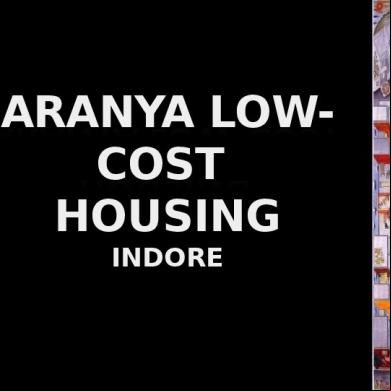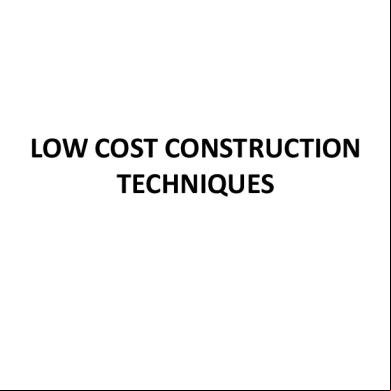Aranya Low Cost Housing.pptx 634xq
This document was ed by and they confirmed that they have the permission to share it. If you are author or own the copyright of this book, please report to us by using this report form. Report 2z6p3t
Overview 5o1f4z
& View Aranya Low Cost Housing.pptx as PDF for free.
More details 6z3438
- Words: 1,314
- Pages: 31
ARANYA LOWCOST HOUSING INDORE
CASE STUDY FACTS
•
•
•Location - 6km from the centre of Indore city, M.P. Client- Indore Development Authority •Principal Architect Balkrishna Doshi •Project Associate - Mr. Himanshu Parikh Structural Engineer - M/s Stein Doshi & Bhalla, New Delhi •Project Engineers -Environmental Engineering Consultants, Bombay •Total Built-up Area -100,000 m2 •Project Cost - Rs. 100 Million
PRE-DESIGN STAGE ANALYSIS Objectives : •To improve and upgrade the existing slum area •To provide serviced sites for new housing developments instead of building complete houses. • To provide for 6,500 residential plots ranging in size from 35m2 for EWS to 475m2 for high income groups Financial Aspects: •The idea was to mix some middle income plots with EWS plots to use the profits to raise capital towards development of local trades. • Funding – 100% public sources. Local sources National Sources
OBJECTI VES The general objectives of Aranya were to: •Create a township with a sense of continuity and fundamental values of security in a good living environment. •Achieve a community character by establishing harmony between the built environment and the people. •Create a balanced community of various socioeconomic groups to evolve a framework through design.
EVOLUTION OF MASTER PLAN
Plan proposed by IDA
Later stage of development to with rectified orientation to minimize heat gain and increase
Initial stage of proposed plan with distributed open spaces and street hierarchy
Proposed master plan
N
DISTRIBUTION OF AMENITIES
•Community facilities grouped in local sub centers. •Formal organization
•Community amenities distributed evenly •Informality created •Accessibility improved • Lower level community facilities organized in green spaces •Even distribution •Maintains link with
ACCESS TO AMMENITIES ( in minutes)
N
THE NEIGHBOURHOOD CONCEPT Concept •Slum development project •Inspiration from existing slum settlements in Indore
Characteristics • Mixed and multiple land use •Formation of small neighborhoods and houses extending to the outdoors. •Small shops operating within congested areas. • Trees planted in
SITE ANALYSIS •Urban Indore city 214 sq. km. •Major development along Delhi – Mumbai highway running through the city in the north south direction • Surroundings: - DelhiMumbai highway on the east - Developing industrial areas on the north, south and west. - Internal city roads to the north, south and west. • Approach through the Delhi – Mumbai highway • Site selection criteria:
Existing features: • 1.85 hectares allotted for existing light industries.
Geographical features: • Flat site •A natural water channel running diagonally across the SW corner. •Top strata of the black cotton soil 2-2.5 m thick. •Gradually sloping (Gradient : 1:110
Township level:
•The aim was to create a central spine. The master plan was informal with interlinked space of cultural context, maintenance of hierarchy of road, open spaces, a central location of basic community services. •The central spine was a focus of the converging six sectors
Six Sector level: •This enabled segregation of pedestrian and vehicular movement, good distribution of built and unbuilt spaces by promoting interactive land use.
N
ZONING I
Resident
commerc
N
ZONING II DISTRIBUTION OF PLOTS ACCORDING TO INCOME GROUPS
Lower income and economically weaker sections of the society EWS
65%
LIG
11%
MIG
14%
uniformly distributed uniformly distributed close to artery
HIERARCHY OF ROADS
60 m 30 m 12 m 15 m 9.5 m 4.5
ROADS •Segregation of vehicular and pedestrian traffic • Offsets break visual monotony •Hierarchy is based on the volume of the traffic and activities
•The roads suit human scale •Use of cul-de-sacs to avoid traffic
CIRCULATION AND LINKAGES
For clear segregation of vehicular and pedestrian traffic: •Vehicular access in the form rectilinear and formal roads in the hierarchy of 4.5m wide to 15m wide road draw the vehicles outwardly. •Pedestrian access in the form of informal interlinked open spaces draws people inwardly.
Vehicular roads
Informal pedestrian pathways and open
HIERARCHY OF OPEN •SPACES Interlinked informal spaces •Continuous system of open spaces is provided • Staggered roads create spaces for community congregation • A single large open space is avoided
Access to open spaces
LAND USE DISTRIBUTION
Ro ads 26 %
Open Spaces 9% Commun ity &Com mercial facilities
Resid enti al Spac e 58%
CLIMATE RESPONSIVE FEATURES • Most of the plots small in size and clustered in low rise blocks • Longer side façade oriented in the north-south axis to reduce the solar radiation on the building. • Each house has minimum exposure to wall surface and a common wall.
The north south orientation of clusters
The building height to street width ratio is such that streets are shaded except when the sun is overhead
CLIMATE RESPONSIVE FEATURES • The two openings on the north and south permit light and cross ventilation. • Courtyards within the houses, cul-de-sacs, public squares and small activity areas shaded adequately by adjacent buildings. • Use of locally available building materials. • Topography used for orientation of major infrastructure network and spatial organization.
Plan showing varied houses with backyards (private open spaces)
SITE AND SERVICE SCHEME OF DESIGN •In this scheme services like water tap, toilets and street lights and a plinth are provided around which houses can have different configurations. •Longer side of a block of row house was oriented north south to reduce solar radiation •Provision of vertical expansions •Housing was seen more as a process than a product
SERVICES SITE AND SERVICE APPROACH •Cost-effective • Progressive development of facilities. • Houses built by the people themselves to suit their needs. •Each family provided with a plot having a water tank, sewerage connection, paved access with street lighting, storm water drainage • Service cores - key to this site and service scheme. - nuclei around which houses were built. • Houses were clustered in groups of 10. • Septic tank provided for every 2 clusters.
SEWERAGE SYSTEM • Major alternatives: - Sewer-less sanitation. -Conventional • Th soil being sewerage system. e so impermeable dept bla il of 2mh, conventio sewer ck was age nal syst adopted. aft thorou em • Designe ertopography gh naturally d slopes – analysis NW towards •of Higher income groups, using more water were located at high ground • Low toincome level generate large flow.. less er waterlocated groups, at ground lower using level •This in 10resulted 15% savings.
TREATMENT •SYSTEM For conveyance system, a wet well and lift station was constructed near the final manhole. - located on the NW corner • Oxidation pond of the site. - removes biological oxygen - simple in operation - effluent suitable for disposal
STORM WATER DRAINAGE SYSTEM •Very efficient and facilitates healthy and clean living. • Combination of underground and surface drainage system. • Underground used for wider roads • Surface drainage used for internal roads ELECTRICITY •High income and middle-income groups were provided with overhead cables. • Economically Weaker Sections were provided with underground cables
CONSTRUCTION DETAILS
•Foundation: Under rimmed piles in concrete, cast in situ locally was used as the soil was black cotton soil. •Structural : Reinforced concrete plinth beams, load bearing brick walls, reinforced concrete slabs.
• Exterior finishes: Bright colour in the façade, railing, grills and cornices seen in the old houses of Indore used in some houses in the township.
• Residents were free to use any material like brick or stone that were locally available
LANDSC • Landscape and green areas include flowering and APE
shade giving trees with thick ground cover, including lantana, an ever-green tree , that requires little maintenance. • Trees include casuarinas, bottle brush and
CONCLUSION
•Consistency in every aspect •Staggered roads, prevent thorough traffic, reduce speed of vehicles •Climate responsive and site responsive
•It understands the traditional Indian habits •Planning and design is in accordance with the prevailing socio-economic and technological conditions •Cost –effective construction materials and techniques have been adopted • Planning is “whole to part” – i.e. From township level to dwelling unit level. • Accessibility has been an essential factor for deg.
PRESENTE D BY:
Utkarsh gupta 9th sem
CASE STUDY FACTS
•
•
•Location - 6km from the centre of Indore city, M.P. Client- Indore Development Authority •Principal Architect Balkrishna Doshi •Project Associate - Mr. Himanshu Parikh Structural Engineer - M/s Stein Doshi & Bhalla, New Delhi •Project Engineers -Environmental Engineering Consultants, Bombay •Total Built-up Area -100,000 m2 •Project Cost - Rs. 100 Million
PRE-DESIGN STAGE ANALYSIS Objectives : •To improve and upgrade the existing slum area •To provide serviced sites for new housing developments instead of building complete houses. • To provide for 6,500 residential plots ranging in size from 35m2 for EWS to 475m2 for high income groups Financial Aspects: •The idea was to mix some middle income plots with EWS plots to use the profits to raise capital towards development of local trades. • Funding – 100% public sources. Local sources National Sources
OBJECTI VES The general objectives of Aranya were to: •Create a township with a sense of continuity and fundamental values of security in a good living environment. •Achieve a community character by establishing harmony between the built environment and the people. •Create a balanced community of various socioeconomic groups to evolve a framework through design.
EVOLUTION OF MASTER PLAN
Plan proposed by IDA
Later stage of development to with rectified orientation to minimize heat gain and increase
Initial stage of proposed plan with distributed open spaces and street hierarchy
Proposed master plan
N
DISTRIBUTION OF AMENITIES
•Community facilities grouped in local sub centers. •Formal organization
•Community amenities distributed evenly •Informality created •Accessibility improved • Lower level community facilities organized in green spaces •Even distribution •Maintains link with
ACCESS TO AMMENITIES ( in minutes)
N
THE NEIGHBOURHOOD CONCEPT Concept •Slum development project •Inspiration from existing slum settlements in Indore
Characteristics • Mixed and multiple land use •Formation of small neighborhoods and houses extending to the outdoors. •Small shops operating within congested areas. • Trees planted in
SITE ANALYSIS •Urban Indore city 214 sq. km. •Major development along Delhi – Mumbai highway running through the city in the north south direction • Surroundings: - DelhiMumbai highway on the east - Developing industrial areas on the north, south and west. - Internal city roads to the north, south and west. • Approach through the Delhi – Mumbai highway • Site selection criteria:
Existing features: • 1.85 hectares allotted for existing light industries.
Geographical features: • Flat site •A natural water channel running diagonally across the SW corner. •Top strata of the black cotton soil 2-2.5 m thick. •Gradually sloping (Gradient : 1:110
Township level:
•The aim was to create a central spine. The master plan was informal with interlinked space of cultural context, maintenance of hierarchy of road, open spaces, a central location of basic community services. •The central spine was a focus of the converging six sectors
Six Sector level: •This enabled segregation of pedestrian and vehicular movement, good distribution of built and unbuilt spaces by promoting interactive land use.
N
ZONING I
Resident
commerc
N
ZONING II DISTRIBUTION OF PLOTS ACCORDING TO INCOME GROUPS
Lower income and economically weaker sections of the society EWS
65%
LIG
11%
MIG
14%
uniformly distributed uniformly distributed close to artery
HIERARCHY OF ROADS
60 m 30 m 12 m 15 m 9.5 m 4.5
ROADS •Segregation of vehicular and pedestrian traffic • Offsets break visual monotony •Hierarchy is based on the volume of the traffic and activities
•The roads suit human scale •Use of cul-de-sacs to avoid traffic
CIRCULATION AND LINKAGES
For clear segregation of vehicular and pedestrian traffic: •Vehicular access in the form rectilinear and formal roads in the hierarchy of 4.5m wide to 15m wide road draw the vehicles outwardly. •Pedestrian access in the form of informal interlinked open spaces draws people inwardly.
Vehicular roads
Informal pedestrian pathways and open
HIERARCHY OF OPEN •SPACES Interlinked informal spaces •Continuous system of open spaces is provided • Staggered roads create spaces for community congregation • A single large open space is avoided
Access to open spaces
LAND USE DISTRIBUTION
Ro ads 26 %
Open Spaces 9% Commun ity &Com mercial facilities
Resid enti al Spac e 58%
CLIMATE RESPONSIVE FEATURES • Most of the plots small in size and clustered in low rise blocks • Longer side façade oriented in the north-south axis to reduce the solar radiation on the building. • Each house has minimum exposure to wall surface and a common wall.
The north south orientation of clusters
The building height to street width ratio is such that streets are shaded except when the sun is overhead
CLIMATE RESPONSIVE FEATURES • The two openings on the north and south permit light and cross ventilation. • Courtyards within the houses, cul-de-sacs, public squares and small activity areas shaded adequately by adjacent buildings. • Use of locally available building materials. • Topography used for orientation of major infrastructure network and spatial organization.
Plan showing varied houses with backyards (private open spaces)
SITE AND SERVICE SCHEME OF DESIGN •In this scheme services like water tap, toilets and street lights and a plinth are provided around which houses can have different configurations. •Longer side of a block of row house was oriented north south to reduce solar radiation •Provision of vertical expansions •Housing was seen more as a process than a product
SERVICES SITE AND SERVICE APPROACH •Cost-effective • Progressive development of facilities. • Houses built by the people themselves to suit their needs. •Each family provided with a plot having a water tank, sewerage connection, paved access with street lighting, storm water drainage • Service cores - key to this site and service scheme. - nuclei around which houses were built. • Houses were clustered in groups of 10. • Septic tank provided for every 2 clusters.
SEWERAGE SYSTEM • Major alternatives: - Sewer-less sanitation. -Conventional • Th soil being sewerage system. e so impermeable dept bla il of 2mh, conventio sewer ck was age nal syst adopted. aft thorou em • Designe ertopography gh naturally d slopes – analysis NW towards •of Higher income groups, using more water were located at high ground • Low toincome level generate large flow.. less er waterlocated groups, at ground lower using level •This in 10resulted 15% savings.
TREATMENT •SYSTEM For conveyance system, a wet well and lift station was constructed near the final manhole. - located on the NW corner • Oxidation pond of the site. - removes biological oxygen - simple in operation - effluent suitable for disposal
STORM WATER DRAINAGE SYSTEM •Very efficient and facilitates healthy and clean living. • Combination of underground and surface drainage system. • Underground used for wider roads • Surface drainage used for internal roads ELECTRICITY •High income and middle-income groups were provided with overhead cables. • Economically Weaker Sections were provided with underground cables
CONSTRUCTION DETAILS
•Foundation: Under rimmed piles in concrete, cast in situ locally was used as the soil was black cotton soil. •Structural : Reinforced concrete plinth beams, load bearing brick walls, reinforced concrete slabs.
• Exterior finishes: Bright colour in the façade, railing, grills and cornices seen in the old houses of Indore used in some houses in the township.
• Residents were free to use any material like brick or stone that were locally available
LANDSC • Landscape and green areas include flowering and APE
shade giving trees with thick ground cover, including lantana, an ever-green tree , that requires little maintenance. • Trees include casuarinas, bottle brush and
CONCLUSION
•Consistency in every aspect •Staggered roads, prevent thorough traffic, reduce speed of vehicles •Climate responsive and site responsive
•It understands the traditional Indian habits •Planning and design is in accordance with the prevailing socio-economic and technological conditions •Cost –effective construction materials and techniques have been adopted • Planning is “whole to part” – i.e. From township level to dwelling unit level. • Accessibility has been an essential factor for deg.
PRESENTE D BY:
Utkarsh gupta 9th sem










